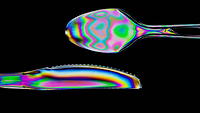U.S. and EU Approaches to Defining and Evaluating Impurities and NIAS in Food Contact Materials

Expressions of concern about impurities in food contact materials have increased over the last few years. While general safety requirements for food contact materials exist in both the United States and the European Union (EU), neither jurisdiction has issued official guidance or regulations pertaining to the manner in which these impurities [better known as nonintentionally added substances (NIAS) in the EU] are evaluated and permitted in food packaging and other food contact materials. The existing regulatory requirements in the U.S. and EU that impact NIAS and impurities in food contact materials are discussed below.
U.S. Requirements
In the U.S., the U.S. Food and Drug Administration (FDA) imposes suitable purity requirements for food contact substances. These requirements are found in the Good Manufacturing Practices (GMP) regulations for food contact substances, which state, in part: “Any substance used as a component of articles that contact food shall be of a purity suitable for its intended use.”[1] Accordingly, a substance can be found to comply with a relevant food additive regulation but still be unsuitable for food contact use if, for example, it contains an unsafe level of impurities or imparts an off taste or off odor to the food.
As a result of the GMP regulations, all foreseeable impurities based on the manufacturing process—such as residual monomers, starting reactants, aids to polymerization, catalysts, and products of incomplete reaction—should be considered. Importantly, oligomers are considered part of polymers in the U.S., not impurities. This is in contrast to EU law, but more on that later.
With respect to food contact substances cleared as indirect food additives and listed in Title 21 of the Code of Federal Regulations (C.F.R.), the regulations will occasionally specify limits for expected impurities. For example, this is the case with polynuclear aromatic hydrocarbon limits in high-purity furnace black.[2] It is important to keep in mind that while most FDA regulations concerning food contact materials do not prescribe specific manufacturing processes, manufacturers must ensure that an indirect food additive is suitably pure under GMP regulations, even if limits for impurities are not specified.
Substances cleared through a food contact notification (FCN) also must meet suitable purity requirements. However, since their clearance is specific to the substance made by the process described in the FCN, any changes in the manufacturing process require a new purity assessment to determine whether there are additional impurities or an increase in the level of any impurity. If the changes in the impurity profile are substantial, a new FCN may need to be submitted.
In its Chemistry Guidance for submitting an FCN,[3] FDA recommends that submitters include detailed information on the intended use and stability of a food contact substance during the intended use conditions, along with a thorough description of possible degradation products and intermediates.
European Union Requirements
The EU also requires that food contact materials and articles be manufactured in compliance with GMPs. This entails ensuring that food contact materials, under normal or foreseeable conditions of use, do not “transfer their constituents to food in quantities which could: (a) endanger human health; or (b) bring about an unacceptable change in the composition of the food; or (c) bring about a deterioration in the organoleptic characteristics thereof.”[4]
The term “NIAS,” as used in the EU, is defined in the Plastics Regulation, (EC) No. 10/2011, as: “[A]n impurity in the substances used or reaction intermediates formed during the production process or decomposition or reaction products.” Therefore, residual monomers and aids to polymerization are not NIAS since they are intentionally added. In contrast, the following are considered NIAS: impurities in monomers and additives, reaction intermediates, breakdown products of aids to polymerization, and oxidation byproducts formed by the reaction of package components with exterior oxygen.
Ironically, oligomers are now considered incomplete products of the reactions used to form polymers and, therefore, reaction intermediates (i.e., NIAS). This reasoning seems consistent with recent European Food Safety Authority (EFSA) opinions suggesting that oligomers are not covered by the monomers listed in the Union List in the Plastics Regulation. However, it seems paradoxical that the only part of a polymer that is actually measured in migration studies and assessed for toxicology purposes is no longer considered a part of the polymer and is now judged no more than an impurity.
The preamble to the Plastics Regulation provides more information on NIAS and how they are regulated. NIAS include impurities in substances used in the manufacture of plastic materials or articles originating from their manufacturing or extraction process (recital 18) and degradation products formed during the manufacture and use of plastic materials and articles (recital 20). The regulation also specifies that if any of these substances are relevant for the risk assessment of the main impurities of a substance or the main reaction and degradation products of the intended application of a substance, they should be included in the specifications and/or restrictions of that substance. Furthermore, these substances may be present in the final material or articles but not included in the Union List. However, if a migration limit for a NIAS is set in the Union List, it must be met.
Evaluation of Impurities to Assess Safety
For the producer of food packaging, or a food packer, to ensure that impurities or NIAS meet safety requirements, a risk assessment may be in order. This can be challenging since, as mentioned above, there are no defined methods for evaluating NIAS. However, several guidance documents have been published that offer some clues on how to conduct risk assessments of NIAS in food contact materials and articles, including ones from the International Life Sciences Institute Europe[5] and Plastics-Europe.[6] However, the recommendations in these guidance documents are not legally binding. Therefore, internationally recognized principles of risk assessment may be relevant for these evaluations.
In general, the information useful in conducting a risk assessment is: (1) the chemical identity and structure of the substance; (2) exposure information; and (3) toxicological safety data. The requirements for determining exposure and conducting the safety evaluation vary between the EU and the U.S. These differences are discussed below.
Chemical identity and structure: The first step is to determine the chemical identity and structure of the NIAS or impurity. This can be based on knowledge of the starting substances or the chemical process, or a search of the literature.
When the identity of a NIAS cannot be determined, an analysis of the substance may be required. This can involve complex testing by multiple methods, such as gas chromatography, high-performance liquid chromatography, nuclear magnetic resonance, and mass spectrometry. It is important to keep in mind that it may not be possible to detect or identify some impurities using existing analytical techniques.
Exposure assessment: The initial step in estimating exposure is to determine the potential extent of migration of the impurity into food. This can be based on data obtained through migration testing using food simulants or food. Since factors such as the type of food (aqueous or acidic, for example) and conditions of duration and temperature of a material in contact with food can impact migration, they need to be considered in protocol design. Additional factors such as the type of packaging material (e.g., film, coating, or rigid article) and the presence of a functional barrier will dictate sample preparation as well. As an alternative to conducting studies, exposure may sometimes be sufficiently established through the use of worst-case assumptions or diffusion modeling.
Once the level of migration is determined, dietary intake can be estimated. In the EU, this may be done using a default assumption for surface-area-to-food volume of 6 dm2 per 1 kg food, a body weight (bw) of 60 kg, and daily food consumption of 17 g food/kg bw (or 1 kg food/60 kg bw).[7]
Rules for determining exposure to food contact substances in the U.S. are different from those in the EU. In the U.S., dietary exposure is established using migration data and consumption factors (CFs). CFs represent the ratio of the weight of all food contacting a specific packaging material to the weight of all packaged food consumed.[8] An exception exists for infant formula since it may account for 100 percent of an infant’s diet; therefore, packaging materials used to hold infant formula likewise account for 100 percent of the CF.
FDA also has developed food-type distribution factors to account for the difference in migration rates that can occur with different types of food (e.g., aqueous, acidic, alcoholic, and fatty) and the types of materials in which they are usually packaged. Differing from Europe, FDA recommends a surface-area-to-food-volume ratio of 1 square inch of surface area to 10 g of food.
Safety evaluation: The safety evaluation involves the identification of adverse toxicological effects or hazards associated with an impurity or NIAS, followed by defining the critical dose or exposure level of that substance in the daily diet (below which the impurity or NIAS is not expected to pose a risk to human health). The first step should be to ascertain what evaluations have already been completed on the substance, such as by EFSA, the UN Joint Expert Committee on Food Additives, FDA, and others. The second step is to review toxicity studies that may have been completed after the evaluation; if no authoritative evaluations have been completed, a search of the literature is necessary.
For NIAS with unknown toxicity but known structure, the threshold of toxicological concern (TTC) can be applied. The TTC is a screening tool that allows for a qualitative risk assessment and prioritizing substances for toxicity testing. The TTC assesses whether a substance is likely to be of concern based on its structure and the estimated exposure. EFSA published a new guidance on the use of the TTC approach in food safety assessment in June 2019.[9]
If none of the options mentioned above apply, toxicity studies may be in order.
In the EU, once it has been determined that a NIAS does not pose any concern with regard to genotoxicity and sufficient chronic or subchronic toxicity data in the form of animal studies are available, a tolerable daily intake (TDI) can be calculated. According to Plastics-Europe’s guide on risk assessment of NIAS, the TDI for a food contact material in the EU is typically calculated by dividing the no-observed-adverse-effect level obtained from an oral subchronic (90-day) study by a safety factor of 100.
In the U.S., FDA applies a tiered approach to the toxicity data requirements for supporting safety assessments of food contact materials, including impurities. The level of safety testing is largely determined by the cumulative estimated daily intake of a food contact substance. For higher levels of potential exposure to a substance, more toxicity data are needed to support safety. FDA has published a guidance on toxicology recommendations for food contact substances that describes the minimum level of safety testing that should be conducted at various exposures.[10]
Conclusion
As attention on impurities in food contact materials continues, regulatory requirements on how they are evaluated may be on the horizon, particularly in the EU. The European Commission is currently evaluating EU legislation on food contact materials.[11] As part of that evaluation, the advantages and disadvantages of using positive lists of substances that may be used in the production of food contact materials are being evaluated. Likewise, in the U.S., FDA faces increasing pressure about the presence of impurities in food contact materials, with congressional representatives requesting the Government Accountability Office to initiate a review of FDA procedures.
George G. Misko, Esq., is a partner in the Washington, DC, office of Keller and Heckman LLP.
References
1. 21 C.F.R. Section 174.5(a)(2).
2. Carbon black is known to contain polynuclear aromatic hydrocarbon (PAH) impurities on its surface. The regulation 21 C.F.R. Section 178.3297 clears “High-purity furnace black” but specifies that PAHs in this cleared color should not exceed 0.5 ppm and the total level of benzo[a]pyrene should not exceed 5.0 ppb. In contrast, the clearance for channel-process carbon black does not include specifications.
3. FDA. Guidance for Industry: Preparation of Premarket Submissions for Food Contact Substances (Chemistry Recommendations) (2007).
4. Regulation (EC) No. 1935/2004 (referred to as the Framework Regulation), Article 3.
5. International Life Sciences Institute Europe. Guidance on Best Practices on the Risk Assessment of Non-Intentionally Added Substances (NIAS) in Food Contact Materials and Articles (2015).
6. Risk Assessment of Non-Listed Substances and Nonintentionally Added Substances Under Article 19.
7. More recently, EFSA suggested the use of different exposure scenarios for specific populations (e.g., infants and toddlers).
8. FDA’s Chemistry Guidance for FCNs includes information on CFs in table 1 of appendix IV.
9. www.efsa.europa.eu/en/efsajournal/pub/5708.
10. www.fda.gov/regulatory-information/search-fda-guidance-documents/guidance-industry-preparation-food-contact-notifications-food-contact-substances-toxicology.
11. ec.europa.eu/food/safety/chemical_safety/food_contact_materials/evaluation_en.
Looking for a reprint of this article?
From high-res PDFs to custom plaques, order your copy today!






